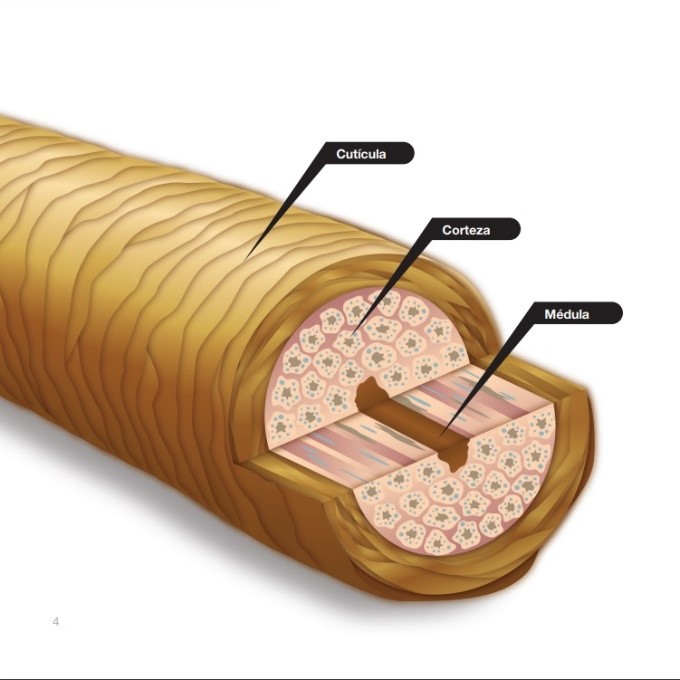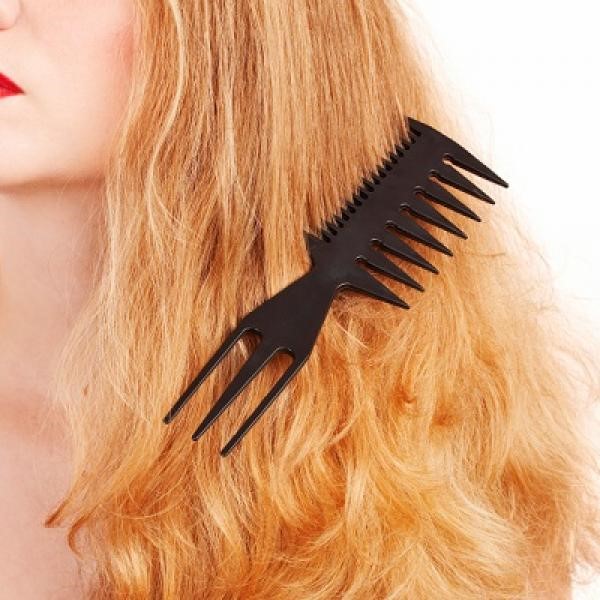Dyeing your hair can be one of the best options to change your look. However, it should be done with caution, as excessive processing can be harmful to hair health and also have adverse effects on the body. In this article we detail everything you need to know about hair dyes and their safer alternatives.
A lot of people dye their hair, but that doesn’t necessarily mean they know what they’re really doing with their hair. Specifically, they may not know what the dye does to hair follicles, from a scientific point of view. Most of us only schedule our monthly appointment at the hair salon or, if we prefer the most economical option, go to the supermarket and choose the dye to do it from home.
Usually we don’t ask ourselves too many questions in this process, we just get used to certain routines and rituals of beauty. On the other hand, it does raise questions when observing changes in the state of our hair.
Actually, it’s about pure, hard science. Below are some facts about what hair dye really does to your hair.
Ammonia lifts capillary cuticle and peroxide destroys color

Hair dyes don’t just rinse the hair and stain it. In fact, to enter the hair stem and settle permanently, it crosses the cuticle, which is the natural protection of the hair. To penetrate beyond the cuticle, the hair dye uses ammonia that elevates the hair pH, relaxes and lifts the cuticle. This results in the hair being damaged, as the cuticle should not be lifted into healthy hair.
Once the cuticle is lifted, the next step is to dye the hair the desired color. So hair dye uses hydrogen peroxide to break down the natural hair pigment. Peroxide is an oxidizing agent that dryers hair considerably, and is the reason why dyed hair can acquire a "straw" texture. It oxidizes the natural pigments of melanin in the hair, eliminating some of the double conjugated bonds that lead to natural color, making them colorless.
When the peroxide developer is absorbed, the cuticle remains raised for the dye to penetrate. The more you lift the cuticle, the more it weakens. Once you rinse the hair, the cuticle comes back down, but the damage is already done.
The damage can go beyond drying the hair

Almost all people who dye their hair know that they should be careful with freshly dyed hair and that they should condition it thoroughly. Hair dyes can definitely dry the hair, but they can also make the hair much more brittle and break if the use of these products becomes routine. To prevent this from happening, you must condition it regularly and use a conditioner that also regenerates the hair as the Redenhair Pro-regenerative Conditioner. It is recommended that this conditioning is carried out before and after bleaching.
Añadir hipervínculo sobre “Acondicionador Pro-Regenerativo” que direccione a la página de compra del producto.
You should also reconsider your haircut. We all like to have a preferred hair color and maintain length, but you may need to be a little flexible if your hair doesn’t respond well to the formula you’re using. To maintain capillary health it is necessary to obtain regular cuts and thus prevent and eliminate split ends. It is much better to keep your hair as healthy as possible and to wear it a little shorter, than to have hair too processed, dry and with split ends.
The ingredients contained in the dyes can be harmful to general health

Hair dyes can not only damage the cuticle. Many of these products contain ingredients derived from coal tar such as aminophenols, diaminobenzenes and phenylenediamines, which have been associated with cancer. Coal tar is a by-product of coal processing and is recognized by the National Toxicology Programme and the International Agency for Cancer Research as a human carcinogen. The Environmental Working Group recommends limiting the use of dark and permanent hair dyes.
It is important to note that researchers have not yet established a fully evident link between dyes and cancer, although some studies in people who dye their hair regularly showed a correlation. Because stylists and other professionals are exposed to the chemicals contained in dyes on a daily basis, European regulators have banned many of these ingredients in dyes. The FDA sanctions the use of coal tar in specialty products, including anti-casp shampoos, but the long-term safety of these products has not yet been verified.
It is also worth noting that allergic reactions to dyes are rare, but not impossible. It is helpful to get a patch test the first time you dye your hair or when you change color. And, if you can, it’s even better to get tested before each application.
Signs of problems caused by dyeing
Every time you color your hair, you should be careful about signs of problems that may appear after using the dye. Any redness of the scalp, irritation, itching, scaling, or blistering should be cause for concern. If your symptoms are severe or last longer than two days, it is highly recommended that you make an appointment with the dermatologist or primary care physician.
Other, less medically important problems may also occur when using these types of products. They often dye the skin of the scalp for a few days, which can be seen with the naked eye. Products that whiten or brighten the hair color remove the protective layer of hair fibers. This makes the hair stem thinner and weaker, being much more susceptible to damage. Using these rinse formulations too often can make the hair look flaccid and lifeless and can even cause hair loss.
Precautions to Take to Avoid Dye Damage
When dyeing your hair with a hair dye, follow these tips to get the best results:
- Perform a patch test, so you can rule out possible allergic reactions before applying hair dye. This type of test can be done on the forearm.
- Always use gloves when applying or mixing hair dye. - Do not leave the dye in your hair any longer than the instructions suggest. - Rinse the scalp thoroughly with water when you are done.
- Never mix different hair dye color formulations.
- Never try to dye eyelashes or eyebrows with hair dye. This can permanently damage your eyes and even cause blindness.
The safest bet is to closely follow all the instructions that come with the dye and avoid formulations that contain PPDA if you are allergic.
Alternatives to hair dyes
If you want to avoid exposure to chemicals contained in most hair dyes, consider trying a natural substitute such as a plant-based henna dye or other completely natural hair color product.
If you use hair dyes to disguise gray hair, you can consider other types of products like Redenhair’s Anticanas line. It is formed by a series of products that contribute to the formation of melanocytes in the hair bulbs, to stimulate the recovery of the natural color of the hair. These products constitute a complete treatment to recover the hair color and prevent the formation of new gray hair. Mind you, if your hair is totally gray, we recommend you try another alternative. You can find the product descriptions below:
Looking to the future, there will be the possibility of buying new hair dyes that are much safer. Researchers at the University of North Carolina have created a database with more than 300 substances to introduce into dyes in order to investigate alternatives to make hair color safer and more sustainable.
And remember…Every month we make sweepstakes and exclusive offers on our Social Media! So follow us on Instagram or Facebook and enjoy our promotions.


 GREYVERSE™, ACTIVE PRINCIPLE OF REDENHAIR ANTI-GREYING RITUAL
GREYVERSE™, ACTIVE PRINCIPLE OF REDENHAIR ANTI-GREYING RITUAL
 Myths about hair fibers Are they harmful to our hair?
Myths about hair fibers Are they harmful to our hair?
 MANY CELEBRITIES ALREADY USE OUR LASER HELMET (LLLT)
MANY CELEBRITIES ALREADY USE OUR LASER HELMET (LLLT)
 REDENHAIR REGENERATING BRUSH VS REDENHAIR REGENERATING HELMET
REDENHAIR REGENERATING BRUSH VS REDENHAIR REGENERATING HELMET
 ENJOY THE BENEFITS OF COLLAGEN WITH REDENHAIR
ENJOY THE BENEFITS OF COLLAGEN WITH REDENHAIR
 SANDALWOOD, ALLY IN THE FIGHT AGAINST ALOPECIA
SANDALWOOD, ALLY IN THE FIGHT AGAINST ALOPECIA
 THE PHASES OF A HAIR TRANSPLANT AND THE ALTERNATIVE REDENHAIR OFFERS YOU
THE PHASES OF A HAIR TRANSPLANT AND THE ALTERNATIVE REDENHAIR OFFERS YOU
 WHAT IS FEMALE ALOPECIA FOR AGING AND HOW TO TREAT IT?
WHAT IS FEMALE ALOPECIA FOR AGING AND HOW TO TREAT IT?
 LATEST TECHNOLOGY FOR HAIR BASED ON LASER LIGHT
LATEST TECHNOLOGY FOR HAIR BASED ON LASER LIGHT
 Saltpeter and hair
Saltpeter and hair
 What is dandruff? What types of dandruff are there?
What is dandruff? What types of dandruff are there?
 At what age can we start using anti-hair loss products?
At what age can we start using anti-hair loss products?
